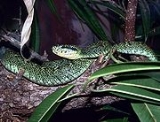
Bothriechis nigroviridis
Encyclopedia
- Common names: black-speckled palm-pitviper, speckled palm viper, more.
Bothriechis nigroviridis is a venomous
Venomous snake
"Poisonous snake" redirects here. For true poisonous snakes, see Rhabdophis.Venomous snakes are snakes which have venom glands and specialized teeth for the injection of venom...
pitviper
Crotalinae
The Crotalinae, commonly known as "pit vipers" or crotaline snakes, are a subfamily of venomous vipers found in Asia and the Americas. They are distinguished by the presence of a heat-sensing pit organ located between the eye and the nostril on either side of the head...
species
Species
In biology, a species is one of the basic units of biological classification and a taxonomic rank. A species is often defined as a group of organisms capable of interbreeding and producing fertile offspring. While in many cases this definition is adequate, more precise or differing measures are...
found in the mountains of Costa Rica
Costa Rica
Costa Rica , officially the Republic of Costa Rica is a multilingual, multiethnic and multicultural country in Central America, bordered by Nicaragua to the north, Panama to the southeast, the Pacific Ocean to the west and the Caribbean Sea to the east....
and Panama
Panama
Panama , officially the Republic of Panama , is the southernmost country of Central America. Situated on the isthmus connecting North and South America, it is bordered by Costa Rica to the northwest, Colombia to the southeast, the Caribbean Sea to the north and the Pacific Ocean to the south. The...
. No subspecies are currently recognized. The specific name is derived from the Latin nigro (black) and viridis (green) in reference to its distinctive color pattern.
Common names
Black-speckled palm-pitviper, speckled palm viper, black-spotted palm viper, yellow-spotted palm viper.Description
Adults may exceed 80 cm, although most are less than 60 cm in length. They are relatively slender and have a prehensile tail. Two exceptionally large females were reported by Hammack and Antonio (1991) that measured 89.2 cm and 93.7 cm.The color pattern usually consists of an emerald green (rarely yellowish green) ground color with strong black mottling. There may also be pale green dorsal blotches that have black edges. The belly is yellowish green and lightly mottled with black. The head is heavily mottled with black on top, often with black parietal stripes. There is also a clearly defined postocular stripe running back towards the angle of the jaw. The iris is heavily stippled and appears almost black. The tongue is also black. Juveniles have a similar color pattern, although it is more pale and the tip of the tail is black.
Geographic range
Found in the mountains of Costa RicaCosta Rica
Costa Rica , officially the Republic of Costa Rica is a multilingual, multiethnic and multicultural country in Central America, bordered by Nicaragua to the north, Panama to the southeast, the Pacific Ocean to the west and the Caribbean Sea to the east....
and Panama
Panama
Panama , officially the Republic of Panama , is the southernmost country of Central America. Situated on the isthmus connecting North and South America, it is bordered by Costa Rica to the northwest, Colombia to the southeast, the Caribbean Sea to the north and the Pacific Ocean to the south. The...
. Also found in the cloud forests of the Cordillera Central and the Cordillera de Talamanca
Cordillera de Talamanca
The Cordillera de Talamanca is a mountain range that lies on the border between Costa Rica and Panama. Much of the range and the area around it is included in the La Amistad International Park, which also is shared between the two countries....
at 1,150-2,400 m altitude. The type locality given is "Vulcan von Barbo" (Volcán Barba, Costa Rica).
According to Campbell and Lamar (2004), this species prefers medium to high elevations from 1,150 to over 3,000 m, and is found from the Cordillera Tilarán and Cordillera Central in the southeastern Alajuela
Alajuela
Alajuela is the second largest city in Costa Rica after the capital, San José. It is also the capital of the namesake province. Because of its location in the Costa Rican Central Valley, Alajuela is nowadays englobed in the conurbation of Great Metropolitan Area...
province in Costa Rica, southeast through the Cordillera de Talamanca to Chiriquí
Chiriquí Province
Chiriquí is a province of Panama, it is located on the western coast of Panama, and it is also the second most developed province in the country, after the Panamá Province. Its capital is the city of David. It has a total area of 6,490.9 km², with a population of 416,873 as of the year 2010...
province in Panama
Panama
Panama , officially the Republic of Panama , is the southernmost country of Central America. Situated on the isthmus connecting North and South America, it is bordered by Costa Rica to the northwest, Colombia to the southeast, the Caribbean Sea to the north and the Pacific Ocean to the south. The...
. It occurs on both the Atlantic and Pacific slopes.
Habitat
This species inhabits high montaneMontane
In biogeography, montane is the highland area located below the subalpine zone. Montane regions generally have cooler temperatures and often have higher rainfall than the adjacent lowland regions, and are frequently home to distinct communities of plants and animals.The term "montane" means "of the...
forest and lower montane wet forest and cloud forest. It has a limited range and is generally considered relatively rare, even though it is locally common in habitat that has not been disturbed. However, Picado (1931) mentioned that they soon disappear from cultivated areas.
Venom
Fatalities have been reported, with the bite symptoms including intense pain, nausea and asphyxiaAsphyxia
Asphyxia or asphyxiation is a condition of severely deficient supply of oxygen to the body that arises from being unable to breathe normally. An example of asphyxia is choking. Asphyxia causes generalized hypoxia, which primarily affects the tissues and organs...
.

